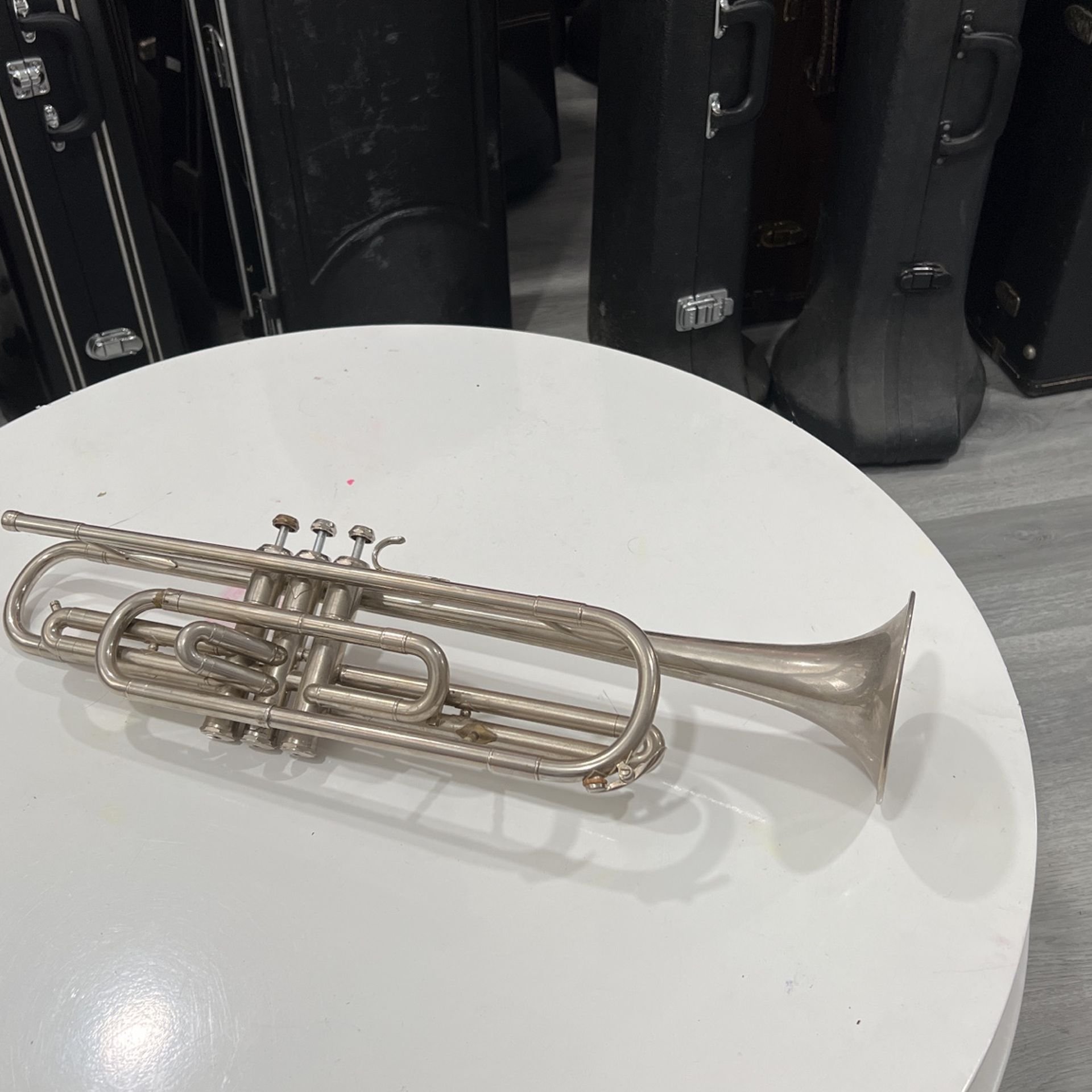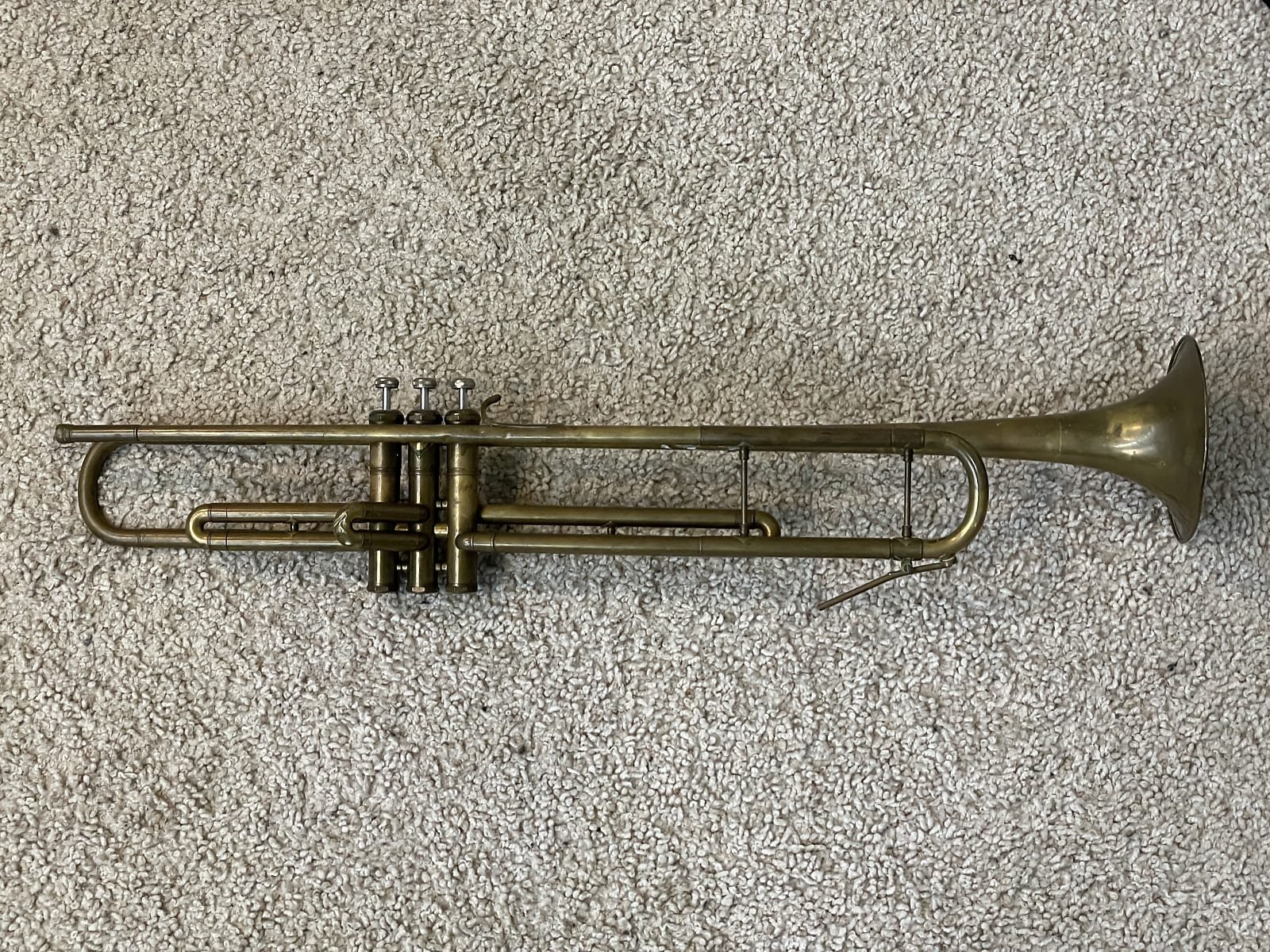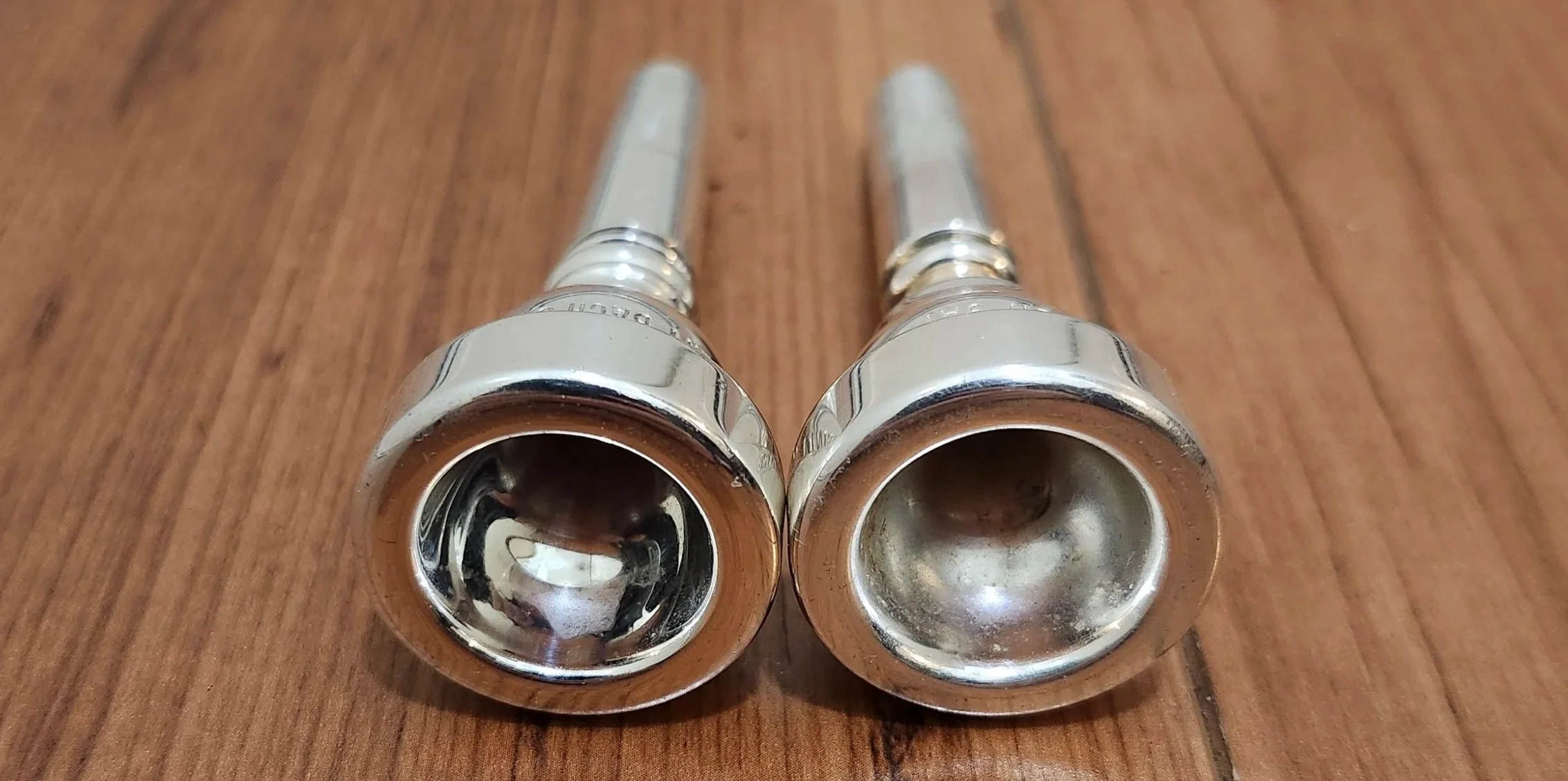Alto Trumpet (and other low-ish trumpets)
Without a doubt, the alto trumpet is the black sheep of the trumpet family.
Built in low F or E-flat, this instrument was allegedly invented by Nikolai Rimsky-Korsakov…at least, that’s what he claims in his treatise on orchestration. Regardless, he wrote for it often and his Russian contemporaries followed suit. But what is it really, and why is it essentially extinct?
The first and most important thing to note is that the alto trumpet is NOT the same instrument as the older orchestral trumpets in low F or E-flat, which are direct descendants of the long natural trumpets that came before and were written for by many popular orchestral composers (Mahler, Strauss, etc.). Those are true trumpets, rather than the mostly-cornet instruments we call “trumpets” today.
Although both the low orchestral trumpet and the alto trumpet are the same length and you might think the distinction is unnecessary, they are completely different instruments. I have experience with both types, and they could not be any more different in sound, feel, and function if they tried. The difference is as large as a modern tuba compared to an ophicleide.
As if two instruments in the same family that are the same length but are completely different was not confusing enough, there is actually a third instrument to throw into the mix: the F or E-flat bass trumpet.
These instruments have a larger bore and bell than alto trumpets and take a trombone mouthpiece, and function essentially the same as the more common C and B-flat bass trumpets. Once again, these instruments are entirely removed from either the low orchestral trumpet or alto trumpet in sound, feel, and function. E-flat bass trumpets are most often seen nowadays in German folk music, for example as the middle voice between a rotary flugelhorn and a large B-flat bass trumpet or bass flugelhorn. Here is a great example:
These three instruments are all trumpets in low F or E-flat, but they are completely different. To summarize:
F/Eb low orchestral trumpet: meant to be played in the same register as a Bb or C trumpet. It’s a natural trumpet with valves, and it plays and sounds as such. Uses a small mouthpiece.
F/Eb alto trumpet: meant to be played a 4th or 5th below the Bb trumpet. Designed from that instrument, rather than from the natural trumpet. Does what the name implies. Uses a mouthpiece in between trumpet and trombone in size (~19mm).
F/Eb bass trumpet: meant to be played roughly an octave below the Bb trumpet, like a C or Bb bass trumpet. Plays and sounds like any other bass trumpet. Uses a trombone mouthpiece.
While none of these instruments are particularly common, low orchestral trumpets are still made by Kuhnl & Hoyer and a few boutique makers (Thein, Egger, Dotzauer), and F/Eb bass trumpets still have a market (Thein, Meinl Weston, Helmut Voigt, Lars Gerdt, likely many more small German and Austrian makers).
This is not the case for the alto trumpet, which is currently made (to my knowledge) by nobody. Why is that?
The easiest explanation is the repertoire.
E-flat bass trumpet does have a few important parts in the orchestra such as the Rite of Spring, but the bass trumpet in C is the orchestral standard for all bass trumpet parts so you’re not likely to see an F or Eb bass trumpet in the orchestra. However, it has an established role in German folk music, and thus will always have a use and thus a market.
While the low orchestral trumpet is sadly totally extinct in the world of modern orchestral trumpeting, a massive portion of the standard orchestral canon was written for it, so there will always be a small interest in them for players that value authenticity or regularly engage in historically-informed orchestral performance.
The alto trumpet doesn’t have any existing use like that to rely on. There is some Russian repertoire for it, but all of those parts were deliberately written within the range of the Bb trumpet so that the part could still be covered if no alto trumpet was available. This is a logical move, but the unfortunate result is that there is zero incentive to get an alto trumpet for those parts. Mahler-style low orchestral trumpets suffer from the same issue; with a few notable exceptions, everything is well within the range of a Bb or C trumpet.
Scythian Suite (Prokofiev) - Movement 2, Trumpet 4 (F alto)
But suppose an intrepid player wanted to honor Rimsky-Korsakov’s intentions and get an F alto trumpet. The player might also point out that there is some research to indicate Wagner’s 3rd trumpet parts might have been intended for a similar instrument, in order to further justify their purchase. Where can they buy one?
Unfortunately, alto trumpet buying options are nearly nonexistent. As previously mentioned, nobody (to my knowledge) makes a new one. The closest thing is a trio of Carol Brass B-flat trumpet models that have alternate slides for G, and in two cases also F: the CTR-5000L-YLT-Bb/G-L, the Tri-KEY PRO, and the Saxy Trumpet Bb/G/F - L. To get one of these you’d also have to find a dealer that would be willing to get one for you, as I haven’t found any online store that stocks them.
You might find some luck with Italian brass makers, as Italian military and police bands are the only place I know of where the alto trumpet has seen regular use, with the 3rd trumpet part often played on F altos instead of Bbs. Those bands are anomalous in other ways too, though - cimbasso, bass trumpets, and Eb soprano flugelhorns are standard features of those bands (though the Eb flugelhorn isn’t so common anymore, usually being substituted by Eb cornet).
The 3 alto trumpeters of the Banda dell’Arma dei Carabinieri, from their 2016 performance at the Kennedy Center. This ensemble also had 2 bass trumpets and a plethora of other uncommon instruments.
As an aside, alto trumpet does have some further history with concert bands. In the spectacular 1923-1924 roster for the University of Illinois Concert Band, one alto trumpet player is listed:
Okay, so what about buying an alto trumpet used? Well, here is a summary of the used alto trumpet market, from my experience:
Bach “contralto” trumpets (made in either F or Eb): enormously rare, and when they do show up for sale they have the Collectible Bach Tax™ and are very expensive. Not that they were cheap when they were new, mind you. I am fortunate enough to own one of these with a gold brass bell (model 351G). The Bach catalogs I’ve seen universally designate this instrument the 187F (with the Eb version being noted as a special order variation), but the only model number on mine is the “351G” stamped on the bell. Technically speaking, both of these numbers are actually part names, for the mouthpipe (187) and bell mandrel (351). I haven’t found a catalog that calls the instrument a 351, but being as Bach C and Bb trumpets are often referred to by their bell mandrel number (37, 229, etc.), it seems reasonable to me that this instrument can also be referred to as a 351. These instruments have a .468” bore, 5¼” bell, and a slightly oversized trumpet shank. The Bach 9AT alto trumpet mouthpiece was designed for this instrument and supplied with it from the factory. I have owned two different 9ATs with two different blanks, and they are a good match for the horn.
Holton 56 (Eb only) and Olds Custom F-10: both ultra rare, and usually expensive.
Conn 34B, 40B, 50B (all Eb only): very rarely show up for sale. If you do manage to find one, beware: everything I have read about them says that they are very stuffy and generally bad to play.
Getzen 389 (F with Eb slide): By far the most common used alto trumpet to show up, but still not common at all. Plus, it’s a student-level instrument that by all accounts is not that great. Make sure to not mistake a Getzen frumpet for one, as they look similar.
Getzen 389 alto trumpet in F and E-flat (E-flat slide installed)
A page from a Getzen catalog showing the frumpet, alto trumpet, and bass trumpet
Amati Kraslice ATR-262 (E-flat): I’ve only seen these show up for sale a handful of times, and there’s no other information out there that I can find. But it appears to be an alto trumpet with a bell big flare.
Kühnl & Hoyer low Ebs (model 599/599K): I include these only to warn you that these are not actually alto trumpets. They look like they should be as they have piston valves and a very normal wrap (in either the short (599K) or long (599) variety), but they are actually long orchestral trumpets like the old rotaries in terrible condition that live on eBay.



3-valve G soprano bugle: The old drum corps G soprano bugles were basically trumpets in low G with an extra-large bore and bell throat. This means that with a suitably large mouthpiece, they actually work very well as a G alto trumpet. As a bonus, the Dynasty 3-valve sopranos show up on eBay quite frequently at very affordable prices (usually $150-250). While these are not in F or Eb and you would thus have to transpose (or get slide extensions made), they can play down to concert Db3, which covers every extra low note in the repertoire except for the low C in Mozart 41 (which is not an important note anyway). Used Kanstul sopranos are less common and more expensive, but generally regarded as the better instrument. You could also buy a brand new Kanstul-pattern one from BAC if you really wanted to.
Dynasty 3-valve soprano bugle in G
My conclusion is simple: every orchestral trumpeter should own a 3-valve G soprano bugle. It costs nearly nothing, plays well, and covers all your extra-low needs. Use it on parts intended for alto trumpet (Rimsky-Korsakov 3rd trumpet parts) even if they don’t go below the range of a Bb. Use it for Carmen, use it for Heldenleben, use it for trumpets 4/5/6 in Mahler 6. Use it for all those old 2nd parts written for natural trumpet that throw in a random 2nd partial note or two (Don Giovanni and Manfred Overture for example).
A-flat Trumpets
A-flat seems like an odd key to build a trumpet in, and I’m not sure how many purpose-built trumpets in A-flat there have been. The few I’ve seen have been normal B-flat trumpets with longer main tuning crooks to put them in B-flat. These don’t really qualify for the alto trumpet discussion, but they do at least give you a whole step of lower range not available on a normal B-flat trumpet.
These A-flat trumpets were built for German Posaunenchor (“trombone choir”), which despite the name has come to refer to any mixed brass ensemble. As far as I’ve been able to find out, the idea of the Posaunenchor A-flat trumpets is to allow trumpet players used to reading C trumpet music on a B-flat trumpet to use the same fingerings on B-flat trumpet music. I have only seen a few turn up for sale on German eBay, but they are out there. I would love to learn more about these instruments, their history in Posaunenchor, and the history of Posaunenchor in general.
A Blessing Scholastic B-flat trumpet converted to A-flat for Posaunenchor use























